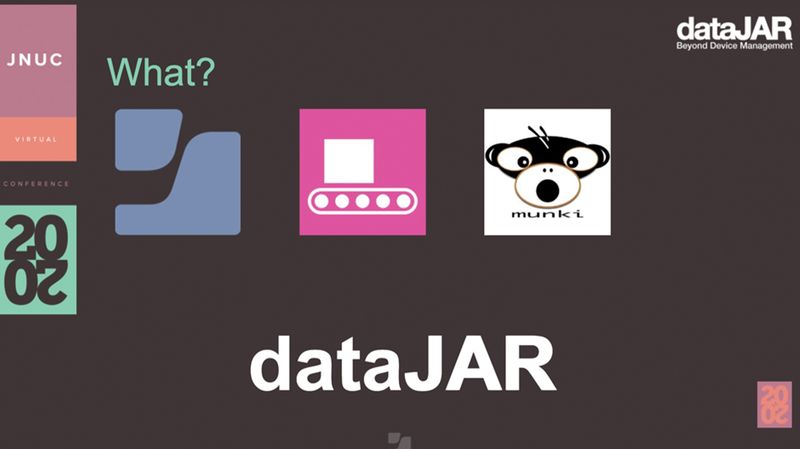Ben Toms, technical director for dataJAR, a Jamf Gold reseller and Jamf preferred managed services partner, led participants in this JNUC panel through updates to jamJAR.
What is jamJAR?
An integration between Jamf Pro, autoPKG and Munki.
Why autoPKG, Munki, and Jamf?
autoPKG is an open-source automation framework for Mac-OS software packaging and distribution oriented toward automating normally manual tasks involved in preparing a third-party software for mass deployments to managed clients engaging in apple device deployment.
"AutoPKG cuts out the faff of packaging software."
Munki offers package info files for all of the software they have with metatada that assists
Jamf solutions have really grown in the past years and are a big part of jamJAR as an MDM and policy engine.
This is a laser-focus on installing software.
How
You'll need working Munki Jamf environments.
LocalOnlyManifest Manifest.plist
The only edition they have to Munki is
/usr/local/munkipostflight
This runs after every single Munki run.
This adds to installs and removes from installs.
With postflight in place and Munki to point to a client, you add a policy script to Jamf with a choice of parameters for adding or removing from installs and uninstalls.
Once you have a policy in place in Jamf, you upload your jamJAR policy script and add a key.
The full scoping and inventory update an admin you would normally do is already part of the packaging profile in the Munki metadata. There's no reason to duplicate the effort.
There are other options, too such as optional installs and seperate policies for titles already installed, the details of which Toms ran through in the session. jamJAR offers notifications and reports on progress and results as well.
What's new
requires: a special key within the package info file that outlines requirements for titles, and then jamJAR knows to install the requirement first.
update_for: this item updates after you've done the install.
macOS upgrades, for instance, updates the Jamf Pro record after an upgrade has been installed.
Erase and install workflows that allow for a once-click button in Self Service that erases the OS and reinstalls it.
Multiple Items: In jamJAR 1.2 released in June 2020, they've added support for multiple items to be added to the jamJAR policy script parameters.
Browser: Also new in jamJAR 1.2 is a muki catalog browser, a macOS clone to be run on a Munki-enrolled device under an admin account. This helps admins with policies and managing jamJAR and Jamf. This catalog is exportable to a .csv.
Notifier support: Notifier is a swift app written by developers at dataJAR which allows admins to post macOS alert notifications and banner notifications on macOS 10.10 clients.
Coming in jamJAR 2.0
jamJAR 2.0 is expected to release soon after Munki 5.1 and will require Munki's shipping of Python 3. dataJAR will offer:
- Added support for the Apple update workflows added to Munki 5
- Changes to macOS updates
jamJAR demo
Toms ran attendees through a brief demo of jamJAR 2.0 in action; view the jamJAR video from JNUC 2020 to see it in action.
Please visit dataJAR's github for JNUC 2020 for even more details.
by Category:
Have market trends, Apple updates and Jamf news delivered directly to your inbox.
To learn more about how we collect, use, disclose, transfer, and store your information, please visit our Privacy Policy.


